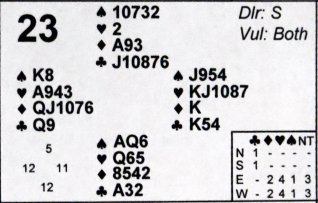I have always preferred the bidding part of the world's best card game. On two of the last five hands I was stuck declaring hands at the one level that no one should be forced to play.
 I was sitting South. The auction on hand #20 was short and sour. East opened 1♥, I overcalled 1♠, and then everyone passed. Apparently the same thing happened at the other tables.
I was sitting South. The auction on hand #20 was short and sour. East opened 1♥, I overcalled 1♠, and then everyone passed. Apparently the same thing happened at the other tables.
I received the most favorable lead imaginable, the king of hearts, but I still managed to take only six tricks. The other declarers made 1♠, and so we got a zero on the hand. I probably should have led trump at every opportunity. I am not sure whether that would have been enough. After I discovered that Deep Finesse reported that the contract cannot be made against the best defense, I was too lazy to go through the effort of playing out the hand in my head under that assumption.
The other hand was #23, which had an even shorter auction. I opened a weak 1NT (12-14), and everyone passed.
 For teams that play the weak notrump this was not an uncommon event. The recommended strategy for the declarer is to try to figure out what the rest of the room was probably playing, calculate their likely score, and then to try to take enough tricks so that your opponents win fewer points than their counterparts at the other table.
For teams that play the weak notrump this was not an uncommon event. The recommended strategy for the declarer is to try to figure out what the rest of the room was probably playing, calculate their likely score, and then to try to take enough tricks so that your opponents win fewer points than their counterparts at the other table.
I started by counting points. I had twelve; my partner had five. So, the opponents had twenty-three, probably not enough for them to bid a notrump game. However, they did have a nine-card fit in hearts. If they had some distribution, they might have a game in hearts, and with nine of them they can probably find it. I considered the three possibilities:
1) If they bid and make a game in hearts, they will earn 620. To beat our counterparts at their table I only would need to take one trick to go down six vulnerable! Since I had three aces, I felt confident in my ability to achieve that goal.
2) If they went down in a contract, we were SOL. There was no way to make 1NT with our hands, and to beat a one-trick set, we would need an overtrick!
3) If they only made a partial, then I needed to take at least six tricks. That would give us a score of -100, which would be better than any partial in hearts. However, any plan that came up with six tricks for North-South must assume that the hearts and the four kings were favorably placed. So, in all likelihood, our fate was entirely in the hands of the people at the other tables. Still, I needed to try to take six tricks because—as unlikely as it seemed—that was the only way that we could earn a good score if the East-West teams made a partial at the other table. The other two possibilities were either impossibly difficult or ridiculously easy.
As it happened, our opponents took the first five tricks in hearts, and then started in on diamonds. I got my aces and the ♠Q, but that was all. We lost 300 points, but both of the other East-West teams made games in hearts. So, we took all the matchpoints.
Could East-West have done better? In this case, neither East nor West had a strong balanced hand. If they had, we might have been faced with playing 1NT doubled, something that no one who plays the weak notrump would enjoy. I am absolutely certain that Ken would not have let us play 1NT doubled.
Every team that plays a weak 1NT should have a contingency plan ready for the situation in which the opponents double the 1NT bid. This plan is called a "runout" or an "escape sequence". Ken and I use a very simple one (called "the DONT runout") that is based on the popular DONT convention that many teams employ against a strong notrump. Ken would have bid 2♣ to indicate that he had clubs and another suit.
If the opponent passed, I would have bid 2♦. I had club support, but I had more diamonds, and both hearts and spades are worth more if I somehow made the contract. If the opponents did not bid, we would end up in 2♠. Our best contract is 2♣, but 2♠ is better than 1NT.
East-West would have been better off if they had overcalled. Against a weak notrump Ken and I play a modified version of the Woolsey defense. It lacks a way for East to interfere, but West could have bid 2♣ to show both majors. Could we have reached 4♥? I don't know. We should probably study the continuations of the Woolsey defense. Maybe the documentation on the Internet is better than the last time that I looked.